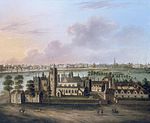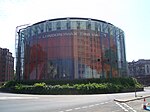St Patrick's Church, Waterloo
1897 establishments in England19th-century Roman Catholic church buildings in the United KingdomChurches in the Diocese of SouthwarkConventual Franciscan churches in the United KingdomRoman Catholic churches completed in 1897 ... and 2 more
Roman Catholic churches in the London Borough of LambethRomanesque Revival church buildings in England

St Patrick's Church is a Roman Catholic parish church in Waterloo, London. It was built in 1897, designed by Frederick Walters. It is a Victorian Romanesque Revival style building that houses both the church and a school. It is located on the corner of Cornwall Street and Secker Street, to the east of St John's Church, Waterloo. It is served by the Franciscan Order of Friars Minor Conventual, and it is their only church in London.
Excerpt from the Wikipedia article St Patrick's Church, Waterloo (License: CC BY-SA 3.0, Authors, Images).St Patrick's Church, Waterloo
Cornwall Road, London Lambeth (London Borough of Lambeth)
Geographical coordinates (GPS) Address Nearby Places Show on map
Geographical coordinates (GPS)
| Latitude | Longitude |
|---|---|
| N 51.504822 ° | E -0.110799 ° |
Address
St Patrick's
Cornwall Road 26
SE1 8TW London, Lambeth (London Borough of Lambeth)
England, United Kingdom
Open on Google Maps











